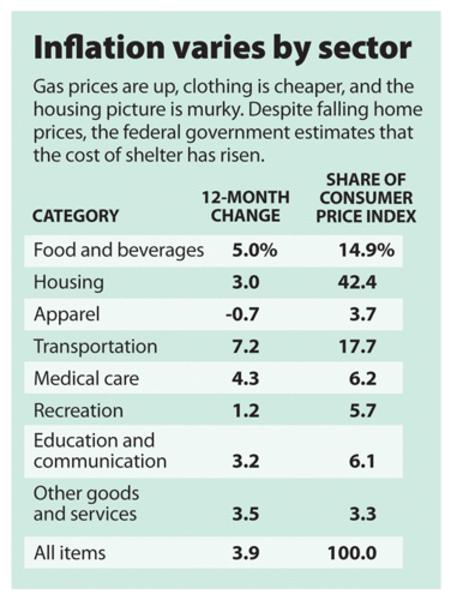If inflation is up 3.9 percent, why does it feel worse?
Between the gas pump and the grocery checkout, Americans have plenty of reasons to list inflation as Economic Enemy No. 1. But how bad is it, really?
The short answer: bad enough, but don't judge the problem only by what it costs to fill a fuel tank.
It's not surprising that many people feel as if inflation is running hotter than the government's consumer price index (CPI) suggests: just under 4 percent over the past year. Many Americans are paying more, especially if they commute long distances or are putting two kids through college. A perception factor is also at work.
The prices now rising fastest are the ones people see the most. Gas prices hit a record $3.76 a gallon Wednesday, according to AAA, up 39 cents in the past month. Food prices in April notched the biggest monthly jump since 1990. So while the prices of some important items bought less frequently – cellphone service, clothing, a house – have fallen or stayed flat, the view at the checkout counter is grim.
Another cause for worry: Wages are not keeping up with inflation.
"It's all bad," says Paul Trapani, referring to his living expenses. The Boston resident says all his costs seem to be rising by at least 5 percent, while pay raises don't match the increase.
"You actually get a pay cut," thanks to the inflation, Mr. Trapani says. "We just had Chinese food. I took out half the rice so I can put it into my gas tank."
Jokes aside, he has hit on a central problem for households across the nation. It's not that the government's inflation rate is understating the problem, many economists say. It's that inflation was higher in 2007 than in any year since 1990, and wages didn't keep up.
That may explain why 47 percent of adults in a recent CNN/Opinion Research poll cited inflation as the biggest economic concern. None of the other concerns, from mortgages to unemployment, scored even half that high.
CPI reliable – but it's an average
"The CPI is a fine, reliable price index as far as it goes," says Jared Bernstein of the Economic Policy Institute in Washington. Yet "it absolutely doesn't reflect the true set of costs that everybody faces."
A person who operates his own trucking business, for example, devotes an outsized slice of income to fuel.
"Truckers are experiencing unprecedented operating cost increases," Todd Spencer, head of a group representing those truckers, told a May 6 hearing in Congress. "[They] are being forced to make tough decisions in the name of saving their businesses and providing for their families."
For other Americans, like Leah Yaroslaski, who works as a food-industry training consultant in Stockton, Calif., the CPI is that far from reality. But she figures that higher energy costs are making it harder for employers to raise salaries.
"If [inflation] goes up any more, we're in trouble," she says.
Her fiancé, Corey Bostwick, notes that one of the key price changes in their lives now is something that's going down: real estate. "We've been thinking about getting into the housing market," he says.
Nationwide, home prices have been falling modestly in the past year. In Stockton, the change is dramatic. Homes that sold not long ago for $350,000 now cost around $200,000, Mr. Bostwick says.
This is a real and significant price shift, but it doesn't show up as such in the CPI. The price index tallies housing by gauging what it would cost to rent a home, so it saw neither this decade's big boom nor its big bust in real estate.
"It's a consumer's price index, not an investor's price index," explains economist Mr. Bernstein.
The basket of goods in the CPI is weighted to reflect the buying patterns of urban consumers, who make up 87 percent of America's population.
Key number for policymakers
Perhaps no economic number has such direct impact on public policy. The CPI determines annual adjustments to Social Security payments and to government programs for people in poverty. It's also the basis of tax-bracket adjustments, which affect who pays 15 percent of income and who pays 25 percent.
Critics say the index has important flaws. But in general, economists across the political spectrum say the system works pretty well.
"There can always be technical quibbles, but the CPI is doing a pretty reasonable job at the task that it's trying to accomplish," says Chad Stone, chief economist at the Center on Budget and Policy Priorities in Washington.
The CPI captures the sticker shock at the pump, for example, showing gas prices up 21 percent over the past 12 months.
The Labor Department's statisticians are "extraordinarily resistant to political pressures," says J.D. Foster of the Heritage Foundation in Washington.
One source of confusion is a parallel measure called "core" inflation, in which the government strips out two of the most volatile components – food and energy.
But this doesn't mean that the government is trying to pretend that food and energy prices don't matter to consumers.
The Federal Reserve pays attention to the core rate in setting monetary policy. The rationale, in part, is for the Fed to target its policy at truly broad-based inflationary pressures. (A spike in oil prices can hit consumers hard, yet may not have roots in lax monetary policy.)
With incomes stagnant, higher gas and food prices may actually have a deflationary influence on other sectors of the economy, some economists say.
"Pricing on these items has sapped purchasing power and demand for an array of other goods," Merrill Lynch chief economist David Rosenberg said in a recent note to clients. Prices have fallen in the past year, he says, for everything from clothing and furniture to toys and TVs.





